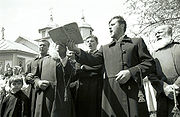
Lipovans
Encyclopedia

Old Believers
In the context of Russian Orthodox church history, the Old Believers separated after 1666 from the official Russian Orthodox Church as a protest against church reforms introduced by Patriarch Nikon between 1652–66...
, mostly of Russian ethnic origin, who settled in the Moldavian Principality
Moldavia
Moldavia is a geographic and historical region and former principality in Eastern Europe, corresponding to the territory between the Eastern Carpathians and the Dniester river...
, in Dobruja
Dobruja
Dobruja is a historical region shared by Bulgaria and Romania, located between the lower Danube river and the Black Sea, including the Danube Delta, Romanian coast and the northernmost part of the Bulgarian coast...
and Eastern Muntenia
Muntenia
Muntenia is a historical province of Romania, usually considered Wallachia-proper . It is situated between the Danube , the Carpathian Mountains and Moldavia , and the Olt River to the west...
. According to the 2002 Romanian census there are a total of 35,791 Lipovans in Romania, of whom 21,623 living in Dobruja.
Name
The name has been suggested to be related to Russian Липа (lipa), linden treeTilia
Tilia is a genus of about 30 species of trees native throughout most of the temperate Northern Hemisphere. The greatest species diversity is found in Asia, and the genus also occurs in Europe and eastern North America, but not western North America...
or to Filippovka, a holiday name dedicated to Saint Philip
Philip the Apostle
Philip the Apostle was one of the Twelve Apostles of Jesus. Later Christian traditions describe Philip as the apostle who preached in Greece, Syria, and Phrygia....
, however, the accepted etymology says it's derived from name of Filipp Pustosviat (1672–1742), the adepts of whom being named filippovcy or (fi)lippovane.
History
They emigrated from Russia over 200 years ago as dissenters with the mainline Russian Orthodox ChurchRussian Orthodox Church
The Russian Orthodox Church or, alternatively, the Moscow Patriarchate The ROC is often said to be the largest of the Eastern Orthodox churches in the world; including all the autocephalous churches under its umbrella, its adherents number over 150 million worldwide—about half of the 300 million...
. They settled along the Prut River in Moldavia
Moldavia
Moldavia is a geographic and historical region and former principality in Eastern Europe, corresponding to the territory between the Eastern Carpathians and the Dniester river...
and in the Danube Delta
Danube Delta
The Danube Delta is the second largest river delta in Europe, after the Volga Delta, and is the best preserved on the continent. The greater part of the Danube Delta lies in Romania , while its northern part, on the left bank of the Chilia arm, is situated in Ukraine . The approximate surface is...
. They have maintained strong religious traditions that predate the reforms of the Russian Orthodox Church
Russian Orthodox Church
The Russian Orthodox Church or, alternatively, the Moscow Patriarchate The ROC is often said to be the largest of the Eastern Orthodox churches in the world; including all the autocephalous churches under its umbrella, its adherents number over 150 million worldwide—about half of the 300 million...
undertaken during the reign of Patriarch Nikon
Patriarch Nikon
Nikon , born Nikita Minin , was the seventh patriarch of the Russian Orthodox Church...
. When he made changes to worship in 1652, part of the believers carried on worshipping in the "old way". In that sense, they continued to speak Old Russian, to cross themselves with two fingers instead of three, and to keep their beards. The Russian government and the Orthodox Church persecuted them and as a result some committed suicide by burning themselves
Self-immolation
Self-immolation refers to setting oneself on fire, often as a form of protest or for the purposes of martyrdom or suicide. It has centuries-long traditions in some cultures, while in modern times it has become a type of radical political protest...
, with many other being forced to emigrate.
In 1876, the Lipovans were joined by some Skoptsy sect members who emigrated to Romania to escape prosecution.
The Lipovans were considered to be schismatic by the Nikonians. However others consider this label to be incorrect.
Population
The main centre of Lipovan community in Ukraine is Vilkovo. The town has its own church, St Nicholas. In order to construct their homes, the Lipovans create islets of dry land by digging mud out from trenches and put into work a series of canals. The house walls are made of reedPhragmites
Phragmites, the Common reed, is a large perennial grass found in wetlands throughout temperate and tropical regions of the world. Phragmites australis is sometimes regarded as the sole species of the genus Phragmites, though some botanists divide Phragmites australis into three or four species...
and mud, and thatching is standard for the roofing. Because of the characteristics of these materials, the buildings have a tendency to sink into the mud and need to be rebuilt every few years.
For details on the Lipovans in Bulgaria, see Russians in Bulgaria
Russians in Bulgaria
Russians form the fourth largest ethnic group in Bulgaria, numbering 9,978 according to the 2011 census, and mostly living in the large urban centres, such as Sofia, Plovdiv, Varna and Burgas...
.
External links
- Second-Hand Souls: Selected Writing by Nichita Danilov (translated from Romanian by Sean Cotter)
- Lipovan's icons: The Bleschunov Municipal Museum of Personal Collections
- Romania. Religious Freedom Report 1999
- Zorile newspaper published in Romanian and Russian

